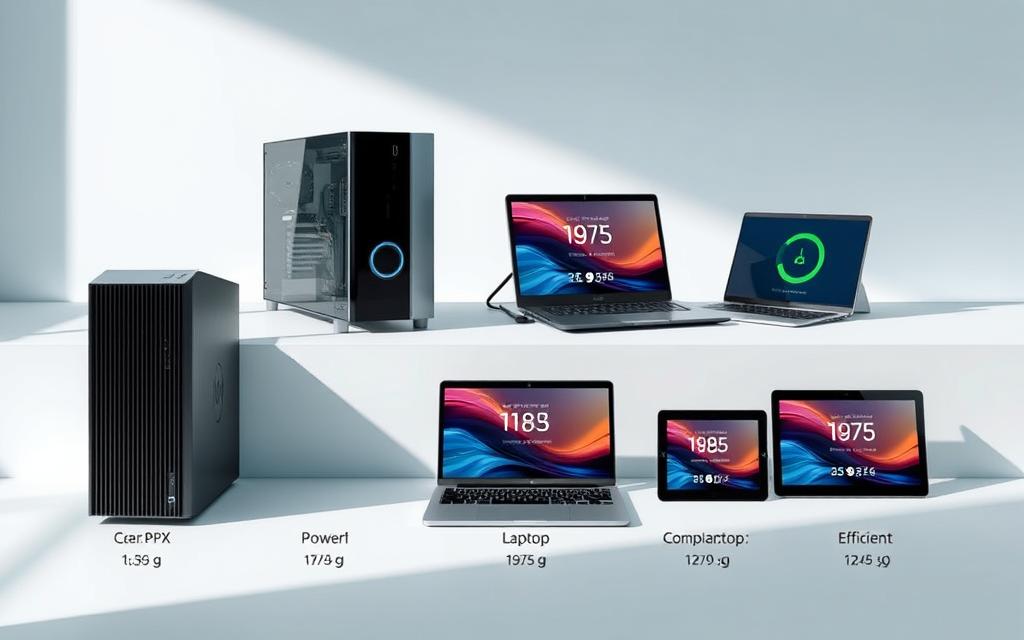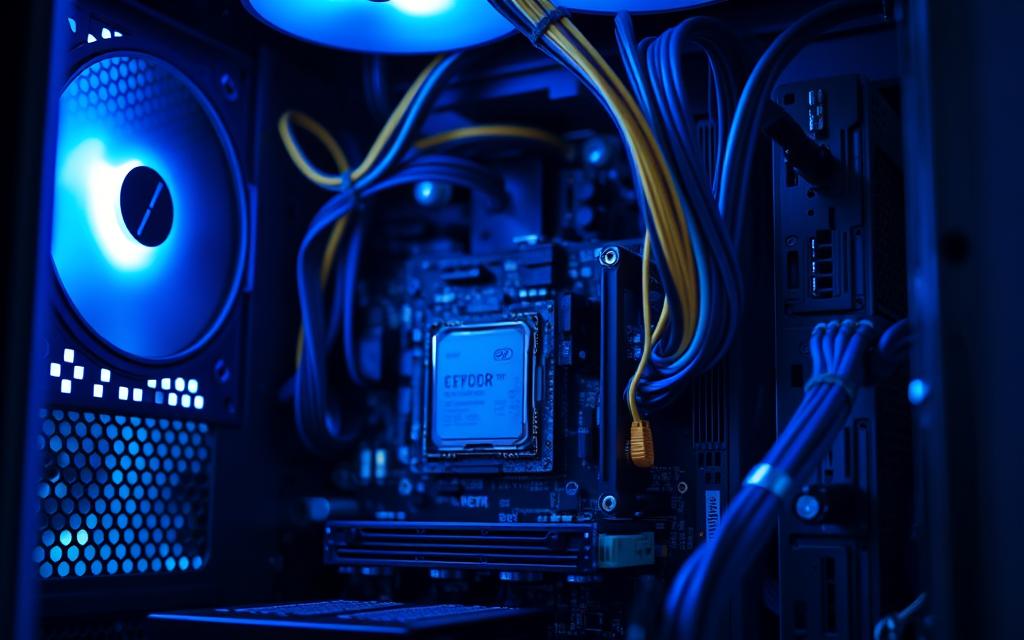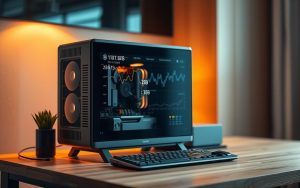Table of Contents
Energy efficiency is becoming a priority for tech users across the U.S. With rising electricity costs and environmental concerns, knowing your device’s power draw matters more than ever. Desktops, laptops, and gaming rigs vary widely in their energy needs, directly impacting monthly bills and sustainability goals.
On average, running a standard setup costs around $20.72 annually. However, high-performance systems can spike this amount significantly. Factors like screen size, hardware specs, and usage duration all influence total consumption.
This guide explores practical ways to measure and reduce power drain. From choosing efficient components to leveraging solar solutions like EnergySage Marketplace, you’ll discover actionable strategies. For detailed benchmarks, see our breakdown of PC energy ranges.
How Many Watts Does a Computer Use? Understanding Power Consumption
Measuring energy use requires knowing volts, amps, and watts. These units define how devices draw electricity from outlets. Think of volts as water pressure, amps as flow rate, and watts as the total power consumed.
Key Electrical Terms Explained
Standard U.S. outlets deliver 120 volts. Most systems draw 3–5 amps, translating to 360–600 watts. One kilowatt-hour (kWh) equals 1,000 watts used for an hour. For example, a 50W device running 8 hours daily consumes 12.2 kWh monthly.
Typical Wattage Ranges
Laptops average 30–70 watts, while desktop computers need 200–500 watts. High-performance setups demand even more. Here’s a yearly comparison at 8 hours/day:
| Device | Wattage | Annual kWh |
|---|---|---|
| Laptop | 30W | 87.6 kWh |
| Laptop | 70W | 204.4 kWh |
| Desktop | 300W | 876 kWh |
At the national average of $0.14 per kWh, a 70W laptop costs ~$28.62 yearly. A 300W desktop? Nearly $122.64. Small changes in power consumption add up fast.
Types of Computers and Their Energy Needs
From ultrabooks to high-performance towers, wattage ranges reflect diverse computing needs. Each device type—laptops, desktops, and gaming PCs—has unique power profiles influenced by hardware and usage.

Laptops: Portability vs. Performance
Standard models use 30–70 watts, but gaming laptops can hit 300W. Chromebooks (20–30W) and ultrabooks (10W) lead in efficiency. Mobile workstations, however, often exceed 70W due to robust CPUs.
Desktops: Traditional vs. All-in-One
A typical desktop draws 200–500 watts. All-in-one PCs cut this by 30% by integrating components. Key factors include GPU choice (250–300W for high-end) and cooling systems.
Gaming PCs: Extreme Power Demands
High-end rigs with dual GPUs can surpass 500W. These systems prioritize performance over efficiency, significantly impacting electricity costs. ENERGY STAR-certified parts help mitigate consumption.
| Device Type | Wattage Range | Annual Cost* |
|---|---|---|
| Ultrabook | 10W | $12.25 |
| Standard Laptop | 50W | $61.25 |
| All-in-One Desktop | 150W | $183.75 |
| Gaming PC | 500W | $612.50 |
*Based on 8 hours/day, $0.14/kWh. Peripherals like 27″ monitors add 30–50W.
Calculating Your Computer’s Electricity Cost
Small daily wattage adds up to significant annual expenses. Whether you’re budgeting or reducing environmental impact, knowing your device’s electricity costs is essential. Here’s how to break it down.
Monthly and Yearly kWh Usage
Multiply wattage by hours used daily, then by 365. A 200W system running 8 hours/day consumes 584 kWh yearly. At $0.16/kWh, that’s $93.44 annually.
Cost Variations by State
Rates differ widely. California averages $0.22/kWh—$128.48 yearly for the same system. Texas at $0.12/kWh? Just $70.08. Check your state’s rate to personalize estimates.
Estimating Your Own Costs
Use this formula: (Wattage × Hours/Day × 365) ÷ 1000 × Rate. For laptops (50W), yearly costs range $14–$33. Desktops (300W) hit $93–$234.
The Hidden Drain of Idle Devices
Energy vampires—like PCs left on—waste standby power. Sleep mode uses 2–5W; full shutdown drops to 0.5W. Ten devices in sleep? That’s $36.68 yearly.
- Hibernate: 0.5W (best for savings)
- Sleep: 5W (convenient but costly)
- Screen Off: 15W (least efficient)
Phantom Energy’s Annual Toll
Households lose $100–$200 yearly to idle electronics. Offices with 20 PCs left on nights/weekends waste $1,200+. Smart plugs with monitors, like Kill-A-Watt, help track and cut waste.
“Frequent boot-ups don’t harm modern hardware. Shutting down saves more than it risks.”
For deeper dives, explore PC energy ranges to compare devices. Every watt saved puts money back in your pocket.
How to Reduce Your Computer’s Energy Consumption
Cutting down on power usage doesn’t mean sacrificing performance—smart tweaks can lower bills. From adjusting system features to unplugging idle gadgets, these strategies tackle electricity use without compromising productivity.

Optimize Power Management Settings
Enable power saver mode to cut energy consumption by 20–30%. On Windows or macOS, set your HDD to sleep after 5 minutes and turn off the display at 10 minutes. Tools like LocalCooling or Joulemeter provide real-time tracking.
For advanced users, BIOS-level optimizations can further refine power management settings. Disable unused ports or background processes to minimize drain.
Combat Peripheral Drain
External devices like printers and USB hubs contribute to peripheral drain. Unplug rarely used accessories—a webcam left connected can add 5W to your daily load. LED monitors use 25% less electricity than LCD models.
“A single charger left plugged in consumes standby power—unplugging it saves up to $10 yearly.”
Master Power Strip Efficiency
Daisy-chain devices to a smart strip with a master switch. This cuts phantom loads from idle gadgets. ENERGY STAR-certified setups save energy with your PC and reduce annual costs by $7–$52.
- Priority Devices: Keep essentials (router, monitor) on always-on outlets.
- Secondary Gear: Connect printers to switched outlets.
With these steps, you’ll trim waste and save money—one watt at a time.
Solar Power and Other Sustainable Solutions
Sustainable computing is no longer a luxury—it’s a necessity for eco-conscious users. With rising electricity costs, integrating solar power into your tech setup can slash bills and carbon footprints. From rooftop panels to portable chargers, renewable options adapt to every need.

Offsetting Home Office Energy Use
A single 350W solar panel can power seven high-end desktops. Calculate your needs: 146 kWh/year equals roughly 1.5 standard panels. Grid-tied systems feed excess energy back, while off-grid setups with battery storage suit remote work.
According to EnergySage, average installation costs $18,000 before incentives. Tax credits and rebates often cut this by 26–30%. Over 20 years, savings typically exceed upfront investments.
Portable Solar for On-the-Go Computing
Foldable 30W chargers fit in backpacks, ideal for laptop users. Compare top brands:
| Brand | Capacity | Key Feature | Price |
|---|---|---|---|
| Jackery | 30W | USB-C fast charging | $99 |
| GoalZero | 28W | Water-resistant | $129 |
| Anker | 21W | Ultra-lightweight | $79 |
Case Study: A remote worker paired a 100W briefcase panel with a power station. This setup fully charges a laptop in 2 hours, eliminating grid reliance during travel.
“Solar isn’t just for homes—it’s a game-changer for mobile professionals.”
Whether you’re powering a home office or a nomadic workstation, renewable solutions save money and reduce environmental impact. Start small with portable options or invest in long-term rooftop arrays.
Conclusion: Smart Choices for Lower Energy Bills
Small adjustments in your tech habits can lead to big savings on your electricity bill. A standard laptop uses 70% less power than a gaming rig, highlighting how device choice impacts costs.
Optimizing settings and upgrading hardware can save money—up to $180 per year. Start with simple tweaks like sleep timers, then explore solar solutions for long-term gains.
At $0.14/kWh, efficient setups cost $20.72 annually versus $32.98 in high-rate states. Ready to cut waste? Use our energy audit checklist or solar calculator to personalize savings.
FAQ
What is the average power consumption of a desktop computer?
A standard desktop typically uses between 200-500 watts under load, while idle usage may drop to 50-100 watts. High-performance models, especially gaming rigs, can exceed 600 watts.
How much electricity does a laptop consume compared to a desktop?
Laptops are far more efficient, averaging 30-70 watts during active use. Their compact design and energy-saving components result in significantly lower power draw than desktops.
Can leaving a computer in sleep mode increase my electric bill?
Sleep mode reduces consumption to 1-5 watts, but over time, this “phantom” energy adds up. For maximum savings, power down completely when not in use for extended periods.
What factors influence a gaming PC’s energy needs?
High-end GPUs like NVIDIA’s RTX 4090 or AMD’s RX 7900 XT demand substantial power—up to 450 watts alone. Processor choice, cooling systems, and RGB lighting also impact total wattage.
How do I calculate my computer’s annual electricity cost?
Multiply your device’s wattage by daily usage hours, then by 365. Divide by 1,000 to get kWh, and multiply by your local rate (e.g.,
FAQ
What is the average power consumption of a desktop computer?
A standard desktop typically uses between 200-500 watts under load, while idle usage may drop to 50-100 watts. High-performance models, especially gaming rigs, can exceed 600 watts.
How much electricity does a laptop consume compared to a desktop?
Laptops are far more efficient, averaging 30-70 watts during active use. Their compact design and energy-saving components result in significantly lower power draw than desktops.
Can leaving a computer in sleep mode increase my electric bill?
Sleep mode reduces consumption to 1-5 watts, but over time, this “phantom” energy adds up. For maximum savings, power down completely when not in use for extended periods.
What factors influence a gaming PC’s energy needs?
High-end GPUs like NVIDIA’s RTX 4090 or AMD’s RX 7900 XT demand substantial power—up to 450 watts alone. Processor choice, cooling systems, and RGB lighting also impact total wattage.
How do I calculate my computer’s annual electricity cost?
Multiply your device’s wattage by daily usage hours, then by 365. Divide by 1,000 to get kWh, and multiply by your local rate (e.g., $0.15/kWh). Example: A 300W PC running 8 hours/day costs ~$131/year.
Are power strips effective for reducing energy waste?
Yes. Smart power strips cut phantom loads by disconnecting peripherals like monitors and printers when the main device (PC) is off, potentially saving $50+ annually.
Can solar panels offset my computer’s energy use?
Absolutely. A 400W solar panel generates enough daily energy (3-4 kWh in sunny regions) to power a desktop for 6+ hours. Portable solar chargers work well for laptops outdoors.
Which power settings save the most energy without sacrificing performance?
Enable Windows/MacOS “Balanced” mode, set displays to sleep after 10 minutes, and disable unnecessary background apps. These tweaks can cut consumption by 20-30%.
.15/kWh). Example: A 300W PC running 8 hours/day costs ~1/year.
Are power strips effective for reducing energy waste?
Yes. Smart power strips cut phantom loads by disconnecting peripherals like monitors and printers when the main device (PC) is off, potentially saving + annually.
Can solar panels offset my computer’s energy use?
Absolutely. A 400W solar panel generates enough daily energy (3-4 kWh in sunny regions) to power a desktop for 6+ hours. Portable solar chargers work well for laptops outdoors.
Which power settings save the most energy without sacrificing performance?
Enable Windows/MacOS “Balanced” mode, set displays to sleep after 10 minutes, and disable unnecessary background apps. These tweaks can cut consumption by 20-30%.









